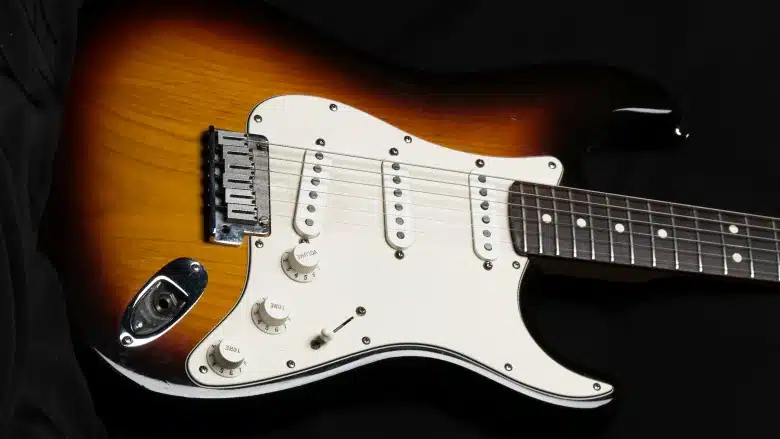Mostly seen in electric guitars and also used in many acoustic guitars, a pickup is like a microphone that ‘picks-up’ the sound of the strings and sends the sound as an electric signal to whatever gear the guitar is connected to (via a cable) like an amplifier, effects pedal or a sound card. Without this, no electric guitar can be heard! So, it is considerably an important part of the electric guitar.

Music comes alive as guitar strings create melodies blending the whispers of the soul into a symphony of emotions.
Acoustic Guitar Pickups
Not only for electric guitars, even acoustic guitars have different types of pickups constructed in various sizes and forms having versatile configurations based on one’s requirements. Guitars having these pickups installed are easily identifiable since they’re the ones with flashy features like on-board tuners and three-band equalizers (lows, mids and highs) seen on the side of the guitar. Although it not necessary, many artists prefer the various pickup options for acoustic guitars especially when played live on a stage or even for recording purposes. These are the various kinds of acoustic guitar pickups:
Piezo Pickup
Also known as the undersaddle pickup, the piezo pickup is installed under the saddle of an acoustic guitar. It is a thin strip of six piezoelectric crystals installed below the guitar’s bridge. This is wired to a phono jack placed at the spot where the strap button usually is. Most versions of this pickup require batteries to operate. This is the most common pickup used in many semi-acoustic guitars. Since it is less prone to unwanted feedback, this works well when performing on a large stage around big speakers and microphones.
Soundhole Pickups
The name comes from the fact that these pickups are mounted across the soundhole of the guitar. These pickups are magnetic and look a lot like the single-coil or the humbucker pickups used in electric guitars. These also have a cable that be connected to an amplifier. Some of these pickups can be removed when not in use. These are also feedback resistant and provide an overall warm tone which may sound a little unnatural at times.
Soundboard Transducers
Also known as contact pickups, soundboard transducer pickups are sensors, usually installed inside the guitar on the bridge plate. The traditional ones had three sensors installed on the bridge plate, under the guitar bridge inside the guitar. Just like the Piezo pickup, the sensors are wired to a phono jack installed on the side of the guitar where the strap button is. Unlike the Piezo pickup which is just put under the bridge inside the body, soundboard pickups can be placed anywhere in the guitar body. These pickups are more prone to feedback especially in a live situation.
There are other options which include combining pickups and internal microphones. These are also required to be installed inside the acoustic guitar body. The microphones are placed near the soundhole, while the pickups are generally under the bridge.
Therefore, there’s two types of tones delivered by the two sources of input, creating a good stereo sound effect. Some expensive semi-acoustic guitars already use such options and the results are quite impressive. However, none of these solutions are comparable to using external microphones which give the best results.
Electric Guitar Pickups
Passive & Active Pickups
So, there are two main types of pickups for electric guitars; passive and active pickups. Passive pickups are the widely used best guitar pickups which does not require any kind of batteries or electricity or any kind of power source. The tone coming from these pickups are even and smooth sounding. They are best suited for almost any genre of music. But they are also critiqued for emitting a bit of unwanted noise.
Contrary to passive pickups, active pickups do require additional power. These pickups have a pre-amp to generate a signal and therefore require batteries as an external power in order for the pickup to be turned on. This may be a drawback especially when the batteries drain out, they may not perform so well. But, these pickups have a more powerful tone preferred by rock/metal enthusiasts. Plus, they are quieter than passive pickups.

Did You Know?
Have you ever considered the types of guitar pickups and how they impact the sound of a guitar? Whether it’s the tones of single coil pickups or the cozy warmth of humbuckers the pickup you choose can truly shape your style as a guitarist.
Apart from that, pickups are also different in terms of size and form factor. We’re going to delve into their construction, their purpose, and which pickups are best suited for the genres of music you love to listen and play.
So, the two types of pickups found on electric guitars are either a single-coil or a humbucker pickups. These are the two pickups that look very different from each other. There is also another type of pickup called the P-90 which is a variation of the single-coil pickup. But this is not so commonly used or seen in electric guitars nowadays.
Single-Coil Pickups
The very first type of pickups invented for the electric guitar are the single-coil pickups. You’ll find these pickups look like just one horizontal strip of six metal circles on a rounded rectangular raised piece of plastic behind the strings. The pickups located near the end of the fret board or the neck. There’s usually two or three of them, depending on the make and model of the guitar.
Basically, a single-coil pickup has six individual electro-magnetic pole pieces (the metal circles) wrapped around a coil of wire inside a frame called a bobbin. There is just one coil of wire and therefore it is named the single-coil pickup.
Generally there are three of these pickups found on the Stratocaster guitars models developed by Fender. One that Is closest to the neck or the fret-board is called the neck pickup. The one closest to the bridge is called the bridge pickup and the one in the middle is referred to as the middle pickup.
The one major drawback of single-coiled pickups is the fact that it has a low noise electromagnetic interference (a small static-like sound) which may affect the overall guitar tone. But there are some guitars with noiseless pickups which has been a significant improvement to the earlier versions.
Humbucker Pickups
The other type of guitar pickups is the double coil or humbucker pickups. These pickups look like two single-coil pickups joined together. You could think of it that way since these have twice the number of magnets found in single-coil pickups and there are two coils wrapped around two sets of magnets with opposing magnetic poles facing the strings. Therefore, they are more effective in cutting off noise (low sounding hum) generated by the single-coil pickups.
However, humbucker pickups may lack the brightness in sound clearly heard in single-coil pickups. Due to the humbucking feature of these pickups, they are extensively used for jazz genres which require a really clean, smooth sound and conversely for heavy rock/metal genres which utilize heavy distortion and high gain effects due to its higher output.
Broadly, there are two types of humbucker pickups found on guitars; the uncovered (open-coil) humbucker pickup where the electro-magnets are clearly seen and the covered humbucker pickup where there is a layer of silver nickel covering the pickup found on more expensive guitars like the Gibson Les Paul.
The uncovered ones are more common since it is probably cheaper. But it gives a brighter and more defined tone. The covered ones with the extra layer of metal alloy on top adds to the function of removing low end humming, reducing the noise even further and gives a warmer sounding tone.
Understanding the Pickup Selector
There is a switch which selects from which of the three pickups the sound is taken and received by the output device (the amp, effects pedal, etc.) the guitar is connected to. This is called the pickup selector. On guitars with three single-coil pickups, the pickup selector has five positions. The first, third and fifth positions selects the sound directly from each one of the pickups (just the neck, middle or bridge pickup). The second and fourth positions combines the sound coming from two pickups combined (either the neck and middle pickups or the middle and bridge pickups).
Overall the tone coming from these pickups vary as you switch positions with the pickup selector. The pickups near the neck sounds a little closed up and mellow while the pickups near the bridge sounds nasal and bright. Depending on the genre of music, the right pickups are activated using the pickup selector. Ideally, the neck and middle pickups are activated for rhythm sections or for smooth strumming while the bridge pickups are selected when playing heavier parts of a song or solos since this pickup sounds brighter and louder.
Additionally you can make use of the tone knob (near the volume knob) to add more brightness to your sound. Depending on the guitar model there may be more than one volume and tone knob. Each volume and tone knob corresponds to a different pickup directly, This gives more control over the sound produced by each and every pickup.
Pickup Configuration
Depending on the make and model of the guitars, some guitars have one humbucker pickup near the bridge along with two single coil pickups. This arrangement is commonly referred to as HSS pickup arrangement. The H stands for the humbucker pickup and S stands for the single-coil pickup. The short form HSS is in order of the pickups placed from the bridge of the guitar to the neck of the guitar. This is a great combination if you want to dynamically switch between different pickups for both a clean and a distorted tone when playing different parts of a song.
Another common pickup configuration found on guitars is the SSS configuration (three single-coil pickups). There are plenty of fender Stratocaster and Telecaster guitars sporting this widely favored pickup arrangement.
Some guitars have just two humbucker pickups; one near the neck and one near the bridge. This arrangement is referred to as HH. The pickup selector switch has only 3 positions. The first position takes the sound from the neck pickup. The middle position combines the sound coming from both pickups while the last position takes the sound from the bridge pickup alone. These guitars are ideal for heavy sounding metal songs especially if you want to show off your soloing or fast picking skills. Conversely this dual-humbucker pickup combination is also preferred by jazz guitarists who are particular about a great clean tone with minimal interference.
Unleash your guitar skills with our, in depth tutorial, on mastering the A Minor Scale. Discover the ins and outs of this scale including techniques, scale shapes and valuable pointers to take your playing to the level!






































